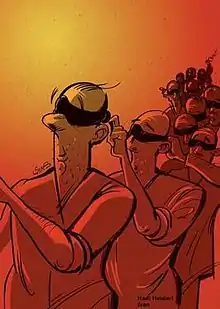Hadi Heidari
Hadi Heidari is an award-winning press cartoonist in Tehran, Iran, whose work has appeared in reformist newspapers including Shargh, Norooz and Neshat.[1] He is 39, and has a degree in painting from Tehran’s Arts and Architecture University.[2] Heidari was imprisoned in 2015 for a cartoon that offended members of the government.
| Hadi Heidari |
|---|
Arrest and imprisonment

Heidari was imprisoned while working at The Shahrvand, a daily newspaper owned by Iran’s Red Crescent Society, the equivalent of the Red Cross.[3] He was sent to Tehran’s Evin Prison to complete a suspended one-year jail sentence imposed in 2013 for his "Blindfold" cartoon, which had been published in the Shargh; leading to a three-month shutdown of that publication.[4]
The Revolutionary Guards had filed a suit against Heidari for his cartoon, which showed a lineup of people, each tying a black blindfold on the next person in line. The cartoon had no caption, leading to several different interpretations.[1] Several politicians alleged that the cartoon had been intentionally released during the week of Holy Defence (a term referring to the eight-year Iran-Iraq war of the 1980s). According to the politicians, the blindfolds "reflected the black headband worn by Iranian soldiers – and suggested that the soldiers went to war blindly",[1] and that the cartoon offended veterans of that war.[2]
Cartoon responding to Paris terror attacks

At the time of his arrest, Heidari had recently gained international attention[5] with another of his cartoons, which depicted the Eiffel Tower in tearful solidarity with the people of France over the attacks on Paris by Islamic State in 2015.[3] Iran's state news media have blamed France’s policies toward Syria for the attacks,[6] and Heidari's imprisonment occurred shortly after his Paris cartoon appeared.[7]
Release
On 26 April 2016, Heidari announced his release, thanking his supporters and posting an image on Instagram of a dove being freed from its cage.[5] It was not the first time he had been imprisoned. During 2009, he was also jailed for several weeks during a crackdown following the disputed re-election of then-President Mahmud Ahmadinejad.[8]
One commentator suggests that in the Muslim world, political cartoons offer a reliable way to get a point across to people who can't read.[9] The US-based Committee to Protect Journalists rates Iran as the fourth most-censored country in the world,[10] and a number of journalists remain in prison.[11]
References
- "Hadi Heidari, creator of controversial "Blindfold" cartoon, finishes serving sentence". Payvand.com. Retrieved 2016-06-15.
- David Schwartz (2015-11-30). "Cartoonist Who Created Iconic Image After Paris Attacks Imprisoned in Iran". Voice Project. Retrieved 2016-06-15.
- "Prominent Iranian Cartoonist Reported Arrested in Tehran". The New York Times. 17 November 2015.
- "Iranian Cartoonist Behind Iconic Paris Image Imprisoned". 17 November 2015.
- 3:18 GMT (2016-04-27). "Imprisoned Iranian Cartoonist Hadi Heidari Goes Free · Global Voices". Globalvoices.org. Retrieved 2016-06-15.
- Morgan Chalfant (2015-11-17). "Report: Iranian Cartoonist Arrested After Drawing Cartoon in Support of France - Washington Free Beacon". Freebeacon.com. Retrieved 2016-06-17.
- "Cartoonist Hadi Heidari jailed in Iran". Cartoonists Rights. Retrieved 2016-06-17.
- Esfandiari, Golnaz (2015-12-04). "Popular Iranian Poet, Songwriter Arrested". Rferl.org. Retrieved 2016-06-15.
- Palmer, Brian (2010-12-13). "Are political cartoons popular in the Muslim world?". Slate.com. Retrieved 2016-06-15.
- http://english.alarabiya.net/en/perspective/features/2013/06/07/Doodle-danger-Iran-cartoonists-on-tightrope-during-election-campaign.html
- Saeed Kamali Dehghan. "Tehran court jails three Iranian journalists for spreading propaganda | World news". The Guardian. Retrieved 2016-06-15.